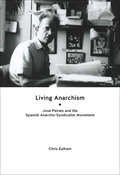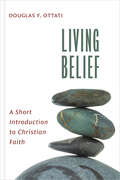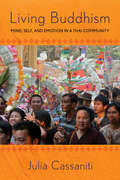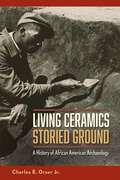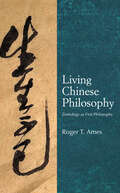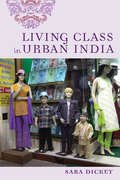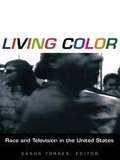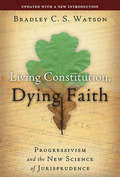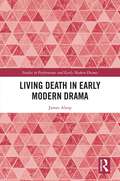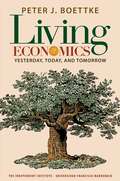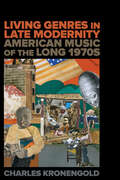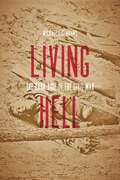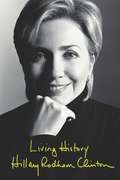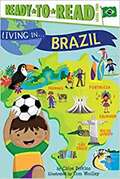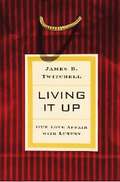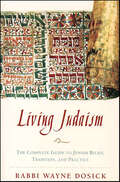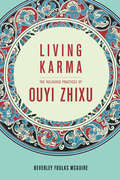- Table View
- List View
Living Anarchism
by Chris Ealham"Magnificent. "--Paul Preston, author ofThe Spanish Holocaust Brick maker by trade, revolutionary anarchist and historian by defau Chris Ealhamis the author ofAnarchism and the City: Revolution and Counter-revolution in Barcelona, 1898-1937.
Living Apart
by Nikole Hannah-JonesProPublica's groundbreaking investigation into housing segregation, and the federal government's large-scale failure to uphold the laws meant to prevent itMore than forty years after President Johnson signed the landmark Fair Housing Act into law, residential segregation in America remains unresolved. Designed to help dismantle the nation's racially divided housing patterns, the act has gone largely ignored by every presidential administration--Democrat and Republican alike--since 1968. In Living Apart, ProPublica investigates this failing, particularly how subsequent leaders, following President Nixon's lead, have declined to use the billions in grant dollars awarded by the Department of Housing and Urban Development as leverage to fight segregation. Their reluctance to enforce a law passed by both houses of Congress and repeatedly upheld by the courts reflects a larger political reality. Again and again, attempts to create integrated neighborhoods have foundered This ebook includes an exclusive afterword by the author, as well as an appendix of original documents dating from the Nixon administration, revealing the internal politics swirling around the Fair Housing Act shortly after its enactment.
Living Belief: A Short Introduction to Christian Faith
by Douglas F. OttatiA leading theologian&’s concise guide to the beliefs, commitments, and practices of Christianity. What do Christians believe? But also, what do they do? And feel? With decades of experience teaching the essentials of Christian faith, Douglas Ottati still finds these questions—and more like them—dynamic and compelling. In Living Belief, he moves beyond trite answers, drawing from the deep well of tradition to offer up wisdom from the Apostles&’ Creed, the Ten Commandments, the Sermon on the Mount, and the Lord&’s Prayer. In so doing, Ottati explores key Christian themes, such as creation, redemption, and love—of neighbor, enemy, and the weak and dependent. Concise and approachable, Living Belief makes no claims to be a definitive account of Christianity but rather attempts &“to introduce a faith that remains a source of meaning and direction, that orients, that encourages and assures, that supplies moral standards and calls for contrition, and that furnishes grounds for perseverance and hope.&” In connection with each chapter, Ottati includes questions for discussion, so that readers—those revisiting the core components of their Christian faith and those learning about it for the first time—can together continue the work, begun here, of understanding the multifaceted life of devotion that is Christianity.
Living Buddhism: Mind, Self, and Emotion in a Thai Community
by Julia CassanitiIn Living Buddhism, Julia Cassaniti explores Buddhist ideas of impermanence, nonattachment, and intention as they are translated into everyday practice in contemporary Thailand. Although most lay people find these philosophical concepts difficult to grasp, Cassaniti shows that people do in fact make an effort to comprehend them and integrate them as guides for their everyday lives. In doing so, she makes a convincing case that complex philosophical concepts are not the sole property of religious specialists and that ordinary lay Buddhists find in them a means for dealing with life's difficulties. More broadly, the book speaks to the ways that culturally informed ideas are part of the psychological processes that we all use to make sense of the world around us. In an approachable first-person narrative style that combines interview and participant-observation material gathered over the course of two years in the community, Cassaniti shows how Buddhist ideas are understood, interrelated, and reinforced through secular and religious practices in everyday life. She compares the emotional experiences of Buddhist villagers with religious and cultural practices in a nearby Christian village. Living Buddhism highlights the importance of change, calmness (as captured in the Thai phrase jai yen, or a cool heart), and karma; Cassaniti's narrative untangles the Thai villagers' feelings and problems and the solutions they seek.
Living Ceramics, Storied Ground: A History of African American Archaeology
by Charles E. Orser Jr.The role of historical archaeology in the study of African diaspora history and culture Exploring the archaeological study of enslavement and emancipation in the United States, this book discusses significant findings, the attitudes and approaches of past researchers, and the development of the field. Living Ceramics, Storied Ground highlights the ways historical archaeology can contribute to the study of African diaspora history and culture, as much of the daily life of enslaved people was not captured through written records but is evidenced in the materials and objects left behind. Including debates about cultural survivals in the 1920s, efforts to find “Africanisms” at Kingsley plantation in the 1960s, and the realization—as late as the 1970s—that colonoware pottery was created by enslaved people, Charles Orser looks at the influential and often mistaken ideas of prominent anthropologists, archaeologists, and historians. Extending to the present, Orser describes how archaeology better recognizes and appreciates the variety and richness of African American culture during slavery, due in large part to the Black archaeologists, past and present, who have worked to counter racism in the field. While acknowledging the colonial legacy of archaeology, Charles Orser outlines the ways the discipline has benefitted by adopting antiracist principles and partnerships with descendant communities. This book points to the contributions of excavators and researchers whose roles have been overlooked and anticipates exciting future work in African American archaeology. Publication of this work made possible by a Sustaining the Humanities through the American Rescue Plan grant from the National Endowment for the Humanities.
Living Chinese Philosophy: Zoetology as First Philosophy (SUNY series in Chinese Philosophy and Culture)
by Roger T. AmesIn Living Chinese Philosophy, Roger T. Ames uses comparative cultural hermeneutics as a method for contrasting classical Greek ontology ("the science of being in itself") with classical Chinese "zoetology" ("the art of living"), which is made explicit in the Yijing 易經 or Book of Changes. Parmenides, Plato, and Aristotle give us a substance ontology grounded in "being qua being" or "being per se" (to on he on) that guarantees a permanent and unchanging subject as the substratum for the human experience. This substratum or essence includes its purpose for being (telos) and defines the "what-it-means-to-be-a-thing-of-this-kind" (eidos) of any particular thing, thus setting a closed, exclusive boundary and the strict identity necessary for a particular thing to be "this" and not "that." In the Book of Changes, we find a vocabulary that makes explicit cosmological assumptions that are a stark alternative to this substance ontology. It also provides the interpretive context for the canonical texts by locating them within a holistic, organic, and ecological worldview. To provide a meaningful contrast with this fundamental assumption of on or "being," we might borrow the Greek notion of zoe or "life" and create the neologism "zoe-tology" as "the art of living" (shengshenglun 生生論). This cosmology begins from "living" (sheng 生) itself as the motive force behind change and gives us a world of boundless "becomings": not "things" that are but "events" that are happening, a contrast between an ontological conception of human "beings" and a process conception of what the author calls human "becomings."
Living Class in Urban India
by Sara DickeyMany Americans still envision India as rigidly caste-bound, locked in traditions that inhibit social mobility. In reality, class mobility has long been an ideal, and today globalization is radically transforming how India's citizens perceive class. Living Class in Urban India examines a nation in flux, bombarded with media images of middle-class consumers, while navigating the currents of late capitalism and the surges of inequality they can produce. Anthropologist Sara Dickey puts a human face on the issue of class in India, introducing four people who live in the "second-tier" city of Madurai: an auto-rickshaw driver, a graphic designer, a teacher of high-status English, and a domestic worker. Drawing from over thirty years of fieldwork, she considers how class is determined by both subjective perceptions and objective conditions, documenting Madurai residents' palpable day-to-day experiences of class while also tracking their long-term impacts. By analyzing the intertwined symbolic and economic importance of phenomena like wedding ceremonies, religious practices, philanthropy, and loan arrangements, Dickey's study reveals the material consequences of local class identities. Simultaneously, this gracefully written book highlights the poignant drive for dignity in the face of moralizing class stereotypes. Through extensive interviews, Dickey scrutinizes the idioms and commonplaces used by residents to justify class inequality and, occasionally, to subvert it. Along the way, Living Class in Urban India reveals the myriad ways that class status is interpreted and performed, embedded in everything from cell phone usage to religious worship.
Living Color: Race and Television in the United States
by Sasha TorresRecent media events like the confirmation hearings for Clarence Thomas, the beating of Rodney King and its aftermath, and the murder trial of O.J. Simpson have trained our collective eye on the televised spectacle of race. Living Color combines media studies, cultural studies, and critical race theory to investigate the representation of race on American TV.Ranging across television genres, historical periods, and racial formations, Living Color--as it positions race as a key element of television's cultural influence--moves the discussion out of a black-and-white binary and illustrates how class, gender, and sexuality interact with images of race. In addition to essays on representations of "Oriental" performers and African Americans in the early years of television, this collection also examines how the celebrity of the late MTV star Pedro Zamora countered racist and homophobic discourses; reveals how news coverage on drug use shifted from the white middle-class cocaine user in the early 1980s to the black "crack mother" of the 1990s; and takes on TV coverage of the Rodney King beating and the subsequent unrest in Los Angeles. Other essays consider O.J. Simpson's murder trial, comparing television's treatment of Simpson to that of Michael Jackson, Magic Johnson, Michael Jordan, and Clarence Thomas and look at the racism directed at Asian Americans by the recurring "Dancing Itos" on Jay Leno's Tonight Show.
Living Constitution, Dying Faith: Progressivism and the New Science of Jurisprudence (American Ideals And Institutions Ser.)
by Bradley C. WatsonA &“living&” constitution. Runaway courts. Legislating from the bench. These phrases come up a lot in the national political debate. They raise the ire of many Americans. But where did the ideas come from? Why do courts play a role so alien to the one the American Founders outlined? And how did unelected judges gain so much power in our democratic republic? Political scientist and legal philosopher Bradley C. S. Watson provides the answers in this important book. To understand why courts today rule the way they do, Watson shows, you must go back more than a century. You&’ll find the philosophical and historical roots of judicial activism in the late nineteenth century. Watson traces a line from social Darwinism and pragmatism, through the rise of Progressivism, to our situation today. Living Constitution, Dying Faith reveals a radical transformation of American political thought. This ebook features a new introduction examining the latest developments—which only highlight the prescience of Watson&’s arguments.
Living Death in Early Modern Drama (ISSN)
by James AlsopThis book explores historical, socio-political, and metatheatrical readings of a whole host of dying bodies and risen corpses, each part of a long tradition of living death on stage.Just as zombies, ghouls, and the undead in modern media often stand in for present-day concerns, early modern writers frequently imagined living death in complex ways that allowed them to address contemporary anxieties. These include fresh bleeding bodies (and body parts), ghostly Lord Mayors, and dying characters who must carefully choose their last words – or have those words chosen for them by the living. As well as offering fresh interpretations of well-known plays such as Middleton’s The Lady’s Tragedy and Webster’s The White Devil, this innovative study also sheds light on less well-known works such as the anonymous The Tragedy of Locrine, Marston’s Antonio’s Revenge, and Munday’s mayoral pageants Chruso-thriambos and Chrysanaleia. The author demonstrates that wherever characters in early modern drama appear to straddle the line between this world and the next, it is rarely a simple matter of life and death.This book will be of great interest to students, scholars, and practitioners in theatre and performance studies, and cultural and social studies.
Living Democracy
by Daniel M. Shea Joanne Green Christopher SmithThe text's innovative approach to American government presents the dynamic nature of our country's democratic process more accurately than any other book currently on the market... This attention-getting text is building on its message of participation: improvements to its innovative pedagogical system with even more assessment opportunities help students participate more fully in their own learning process, while new Student Profiles of politically active young people from around the world continue to promote students' political participation.
Living Economics: Yesterday, Today, and Tomorrow
by Peter J. BoettkeEconomics is not merely a game to be played by clever professionals, but a discipline that touches upon the most pressing practical issues at any historical juncture. The wealth and poverty of nations is at stake; the length and quality of life turns on the economic conditions individuals find themselves living within. Touching upon a variety of subjects—including market socialism, political economy, and economics education—this reference contains the wisdom of an expert in the field, Peter J. Boettke.The passion of the teacher is often the inspiration for a student. Living Economics illuminates how economics affects all walks of life, whether in the marketplace, voting booth, church, family, or any human activity. Boettke believes that economics is not merely a game to be played by clever professionals, but a discipline that touches on the most pressing practical issues at any historical juncture. The wealth and poverty of nations are at stake; the length and quality of life turns on the economic conditions individuals find themselves living with. So teaching and learning economics are high stakes ventures. Along the way he introduces us to major thinkers: from the Late Scholastics in 16th- and 17th-century Spain to Smith, Say, and Bastiat of the Classical School, to Austrian School scholars (Menger, Mises, Hayek, Kirzner, and Rothbard) on to New Institutional economists (Alchian, Coase, Demsetz, North, Ostrom and Williamson) and Public Choice theorists (Buchanan, Tullock, and others). This engaging and reasoned book is a must-read for economists, students, and everyone else who wishes to better understand economics. A great supplemental text for the teaching of economics, this book offers a clear perspective and a passion for a deeper understanding of the subject.
Living Emergency: Israel's Permit Regime in the Occupied West Bank
by Yael BerdaIn 1991, the Israeli government introduced emergency legislation canceling the general exit permit that allowed Palestinians to enter Israel. The directive, effective for one year, has been reissued annually ever since, turning the Occupied Territories into a closed military zone. Today, Israel's permit regime for Palestinians is one of the world's most extreme and complex apparatuses for population management. Yael Berda worked as a human rights lawyer in Jerusalem and represented more than two hundred Palestinian clients trying to obtain labor permits to enter Israel from the West Bank. With Living Emergency, she brings readers inside the permit regime, offering a first-hand account of how the Israeli secret service, government, and military civil administration control the Palestinian population. Through interviews with Palestinian laborers and their families, conversations with Israeli clerks and officials, and research into the archives and correspondence of governmental organizations, Berda reconstructs the institutional framework of the labyrinthine permit regime, illuminating both its overarching principles and its administrative practices. In an age where terrorism, crime, and immigration are perceived as intertwined security threats, she reveals how the Israeli example informs global homeland security and border control practices, creating a living emergency for targeted populations worldwide.
Living Faith: Everyday Religion and Mothers in Poverty
by Sullivan Susan CrawfordScholars have made urban mothers living in poverty a focus of their research for decades. These women’s lives can be difficult as they go about searching for housing and decent jobs and struggling to care for their children while surviving on welfare or working at low-wage service jobs and sometimes facing physical or mental health problems. But until now little attention has been paid to an important force in these women’s lives: religion. Based on in-depth interviews with women and pastors, Susan Crawford Sullivan presents poor mothers’ often overlooked views. Recruited from a variety of social service programs, most of the women do not attend religious services, due to logistical challenges or because they feel stigmatized and unwanted at church. Yet, she discovers, religious faith often plays a strong role in their lives as they contend with and try to make sense of the challenges they face. Supportive religious congregations prove important for women who are involved, she finds, but understanding everyday religion entails exploring beyond formal religious organizations. Offering a sophisticated analysis of how faith both motivates and at times constrains poor mothers’ actions, Living Faith reveals the ways it serves as a lens through which many view and interpret their worlds.
Living Genres in Late Modernity: American Music of the Long 1970s
by Charles KronengoldLiving Genres in Late Modernity rehears the American 1970s through the workings of its musical genres. Exploring stylistic developments from the late 1960s through the early 1980s, including soul, funk, disco, pop, the nocturne, and the concerto, Charles Kronengold treats genres as unstable constellations of works, people, practices, institutions, technologies, money, conventions, forms, ideas, and multisensory experiences. What these genres share is a significant cultural moment: they arrive just after "the sixties" and are haunted by a sense of belatedness, loss, or doubt, even as they embrace narratives of progress or abundance. These genres give us reasons—and means—to examine our culture’s self-understandings. Through close readings and large-scale mappings of cultural and stylistic patterns, the book’s five linked studies reveal how genres help construct personal and cultural identities that are both partial and overlapping, that exist in tension with one another, and that we experience in ebbs and flows.
Living Hell: The Dark Side of the Civil War
by Michael C. AdamsA senior military historian presents an unflinching account of the human costs of the Civil War.Many Americans, argues Michael C. C. Adams, tend to think of the Civil War as more glorious, less awful, than the reality. Millions of tourists flock to battlefields each year as vacation destinations, their perceptions of the war often shaped by reenactors who work hard for verisimilitude but who cannot ultimately simulate mutilation, madness, chronic disease, advanced physical decay. In Living Hell, Adams tries a different tack, clustering the voices of myriad actual participants on the firing line or in the hospital ward to create a virtual historical reenactment.Perhaps because the United States has not seen conventional war on its own soil since 1865, the collective memory of its horror has faded, so that we have sanitized and romanticized even the experience of the Civil War. Neither film nor reenactment can fully capture the hard truth of the four-year conflict. Living Hell presents a stark portrait of the human costs of the Civil War and gives readers a more accurate appreciation of its profound and lasting consequences.Adams examines the sharp contrast between the expectations of recruits versus the realities of communal living, the enormous problems of dirt and exposure, poor diet, malnutrition, and disease. He describes the slaughter produced by close-order combat, the difficulties of cleaning up the battlefields—where tens of thousands of dead and wounded often lay in an area of only a few square miles—and the resulting psychological damage survivors experienced.Drawing extensively on letters and memoirs of individual soldiers, Adams assembles vivid accounts of the distress Confederate and Union soldiers faced daily: sickness, exhaustion, hunger, devastating injuries, and makeshift hospitals where saws were often the medical instrument of choice. Inverting Robert E. Lee’s famous line about war, Adams suggests that too many Americans become fond of war out of ignorance of its terrors. Providing a powerful counterpoint to Civil War glorification, Living Hell echoes William Tecumseh Sherman’s comment that war is cruelty and cannot be refined.Praise for Our Masters the Rebels: A Speculation on Union Military Failure in the East, 1861–1865"This excellent and provocative work concludes with a chapter suggesting how the image of Southern military superiority endured in spite of defeat."—Civil War History"Adams's imaginative connections between culture and combat provide a forceful reminder that Civil War military history belongs not in an encapsulated realm, with its own categories and arcane language, but at the center of the study of the intellectual, social, and psychological currents that prevailed in the mid-nineteenth century."—Journal of American HistoryPraise for The Best War Ever: America and World War II"Adams has a real gift for efficiently explaining complex historical problems."—Reviews in American History"Not only is this mythologizing bad history, says Adams, it is dangerous as well. Surrounding the war with an aura of nostalgia both fosters the delusion that war can cure our social ills and makes us strong again, and weakens confidence in our ability to act effectively in our own time."—Journal of Military History
Living History
by Hillary Rodham ClintonHillary Rodham Clinton is known to hundreds of millions of people around the world. Yet few beyond her close friends and family have ever heard her account of her extraordinary journey. She writes with candor, humor and passion about her upbringing in suburban, middle-class America in the 1950s and her transformation from Goldwater Girl to student activist to controversial First Lady. Living History is her revealing memoir of life through the White House years. It is also her chronicle of living history with Bill Clinton, a thirty-year adventure in love and politics that survives personal betrayal, relentless partisan investigations and constant public scrutiny. Hillary Rodham Clinton came of age during a time of tumultuous social and political change in America. Like many women of her generation, she grew up with choices and opportunities unknown to her mother or grandmother. She charted her own course through unexplored terrain -- responding to the changing times and her own internal compass -- and became an emblem for some and a lightning rod for others. Wife, mother, lawyer, advocate and international icon, she has lived through America's great political wars, from Watergate to Whitewater. The only First Lady to play a major role in shaping domestic legislation, Hillary Rodham Clinton traveled tirelessly around the country to champion health care, expand economic and educational opportunity and promote the needs of children and families, and she crisscrossed the globe on behalf of women's rights, human rights and democracy. She redefined the position of First Lady and helped save the presidency from an unconstitutional, politically motivated impeachment. Intimate, powerful and inspiring, Living History captures the essence of one of the most remarkable women of our time and the challenging process by which she came to define herself and find her own voice -- as a woman and as a formidable figure in American politics.
Living History
by Hillary Rodham ClintonHillary Rodham Clinton is known to hundreds of millions of people around the world. Yet few beyond her close friends and family have ever heard her account of her extraordinary journey. She writes with candor, humor and passion about her upbringing in suburban, middle-class America in the 1950s and her transformation from Goldwater Girl to student activist to controversial First Lady. Living History is her revealing memoir of life through the White House years. It is also her chronicle of living history with Bill Clinton, a thirty-year adventure in love and politics that survives personal betrayal, relentless partisan investigations and constant public scrutiny. Hillary Rodham Clinton came of age during a time of tumultuous social and political change in America. Like many women of her generation, she grew up with choices and opportunities unknown to her mother or grandmother. She charted her own course through unexplored terrain -- responding to the changing times and her own internal compass -- and became an emblem for some and a lightning rod for others. Wife, mother, lawyer, advocate and international icon, she has lived through America's great political wars, from Watergate to Whitewater. The only First Lady to play a major role in shaping domestic legislation, Hillary Rodham Clinton traveled tirelessly around the country to champion health care, expand economic and educational opportunity and promote the needs of children and families, and she crisscrossed the globe on behalf of women's rights, human rights and democracy. She redefined the position of First Lady and helped save the presidency from an unconstitutional, politically motivated impeachment. Intimate, powerful and inspiring, Living History captures the essence of one of the most remarkable women of our time and the challenging process by which she came to define herself and find her own voice -- as a woman and as a formidable figure in American politics.
Living I Was Your Plague: Martin Luther's World and Legacy (The Lawrence Stone Lectures #20)
by Lyndal RoperFrom the author of the acclaimed biography Martin Luther: Renegade and Prophet, new perspectives on how Luther and others crafted his larger-than-life imageMartin Luther was a controversial figure during his lifetime, eliciting strong emotions in friends and enemies alike, and his outsized persona has left an indelible mark on the world today. Living I Was Your Plague explores how Luther carefully crafted his own image and how he has been portrayed in his own times and ours, painting a unique portrait of the man who set in motion a revolution that sundered Western Christendom.Renowned Luther biographer Lyndal Roper examines how the painter Lucas Cranach produced images that made the reformer an instantly recognizable character whose biography became part of Lutheran devotional culture. She reveals what Luther's dreams have to say about his relationships and discusses how his masculinity was on the line in his devastatingly crude and often funny polemical attacks. Roper shows how Luther's hostility to the papacy was unshaken to the day he died, how his deep-rooted anti-Semitism infused his theology, and how his memorialization has given rise to a remarkable flood of kitsch, from "Here I Stand" socks to Playmobil Luther.Lavishly illustrated, Living I Was Your Plague is a splendid work of cultural history that sheds new light on the complex and enduring legacy of Luther and his image.
Living In, Living Out
by Elizabeth Clark-LewisThis oral history portrays the lives of African American women who migrated from the rural South to work as domestic servants in Washington, DC in the early decades of the twentieth century. In Living In, Living Out Elizabeth Clark-Lewis narrates the personal experiences of eighty-one women who worked for wealthy white families. These women describe how they encountered--but never accepted--the master-servant relationship, and recount their struggles to change their status from "live in" servants to daily paid workers who "lived out."With candor and passion, the women interviewed tell of leaving their families and adjusting to city life "up North," of being placed as live-in servants, and of the frustrations and indignities they endured as domestics. By networking on the job, at churches, and at penny savers clubs, they found ways to transform their unending servitude into an employer-employee relationship--gaining a new independence that could only be experienced by living outside of their employers' homes. Clark-Lewis points out that their perseverance and courage not only improved their own lot but also transformed work life for succeeding generations of African American women. A series of in-depth vignettes about the later years of these women bears poignant witness to their efforts to carve out lives of fulfillment and dignity.
Living In...Brazil: Ready-to-read Level 2 (Living In...Series)
by Tom Woolley Chloe PerkinsJust in time for the 2016 Olympics in Rio de Janeiro, discover what it’s like growing up in Brazil with this fascinating, nonfiction Level 2 Ready-to-Read, part of a new series all about kids just like you in countries around the world! Olá! My name is Marco, and I’m a kid just like you living in Brazil. Brazil is a country filled with beautiful rain forests, bustling cities, and world-class sports. Have you ever wondered what living in Brazil is like? Come along with me to find out! Each book is narrated by a kid growing up in their home country and is filled with fresh, modern illustrations as well as loads of history, geography, and cultural goodies that fit perfectly into Common Core standards. Join kids from all over the world on a globe-trotting adventure with the Living in… series—sure to be a hit with children, parents, educators, and librarians alike!
Living Islam Out Loud
by Saleemah Abdul-GhafurLiving Islam Out Loud presents the first generation of American Muslim women who have always identified as both American and Muslim. These pioneers have forged new identities for themselves and for future generations, and they speak out about the hijab, relationships, sex and sexuality, activism, spirituality, and much more. Contributors: Su'ad Abdul-Khabeer, Sham-e-Ali al-Jamil, Samina Ali, Sarah Eltantawi, Yousra Y. Fazili, Suheir Hammad, Mohja Kahf, Precious Rasheeda Muhammad, Asra Q. Nomani, Manal Omar, Khalida Saed, Asia Sharif-Clark, Khadijah Sharif-Drinkard, Aroosha Zoq Rana, Inas Younis
Living It Up: Our Love Affair with Luxury
by James B. TwitchellEconomic downturns and terrorist attacks notwithstanding, America's love affair with luxury continues unabated. Over the last several years, luxury spending in the United States has been growing four times faster than overall spending. It has been characterized by political leaders as vital to the health of the American economy as a whole, even as an act of patriotism. Accordingly, indices of consumer confidence and purchasing seem unaffected by recession. This necessary consumption of unnecessary items and services is going on at all but the lowest layers of society: J.C. Penney now offers day spa treatments; Kmart sells cashmere bedspreads. So many products are claiming luxury status today that the credibility of the category itself is strained: for example, the name "pashmina" had to be invented to top mere cashmere.We see luxury everywhere: in storefronts, advertisements, even in the workings of our imaginations. But what is it? How is it manufactured on the factory floor and in the minds of consumers? Who cares about it and who buys it? And how concerned should we be that luxuries are commanding a larger and larger percentage of both our disposable income and our aspirations?Trolling the upscale malls of America, making his way toward the Mecca of Las Vegas, James B. Twitchell comes to some remarkable conclusions. The democratization of luxury, he contends, has been the single most important marketing phenomenon of our times. In the pages of Living It Up, Twitchell commits the academic heresy of paying respect to popular luxury consumption as a force that has united the country and the globe in a way that no war, movement, or ideology ever has. What's more, he claims, the shopping experience for Americans today has its roots in the spiritual, the religious, and the transcendent.Deft and subtle writing, audacious ideas, and a fine sense of humor inform this entertaining and insightful book.
Living Judaism: The Complete Guide to Jewish Belief, Tradition, and Practice
by Wayne D. DosickIn Living Judaism, Rabbi Wayne Dosick, Ph.D., author the acclaimed Golden Rules, Dancing with God, and When Life Hurts, offers an engaging and definitive overview of Jewish philosophy and theology, rituals and customs. Combining quality scholarship and sacred spiritual instruction, Living Judaism is a thought-provoking reference and guide for those already steeped in Jewish life, and a comprehensive introduction for those exploring the richness and grandeur of Judaism.
Living Karma: The Religious Practices of Ouyi Zhixu (The Sheng Yen Series in Chinese Buddhist Studies)
by Beverley McGuireOuyi Zhixu (1599–1655) was an eminent Chinese Buddhist monk who, contrary to his contemporaries, believed karma could be changed. Through vows, divination, repentance rituals, and ascetic acts such as burning and blood writing, he sought to alter what others understood as inevitable and inescapable. Drawing attention to Ouyi's unique reshaping of religious practice, Living Karma reasserts the significance of an overlooked individual in the modern development of Chinese Buddhism.While Buddhist studies scholarship tends to privilege textual analysis, Living Karma promotes a balanced study of ritual practice and writing, treating Ouyi's texts as ritual objects and his reading and writing as religious acts. Each chapter addresses a specific religious practice—writing, divination, repentance, vows, and bodily rituals—offering first a diachronic overview of each practice within the history of Chinese Buddhism and then a synchronic analysis of each phenomenon through close readings of Ouyi's work. This book sheds much-needed light on a little-known figure and his representation of karma, which proved to be a seminal innovation in the religious thought of late imperial China.
